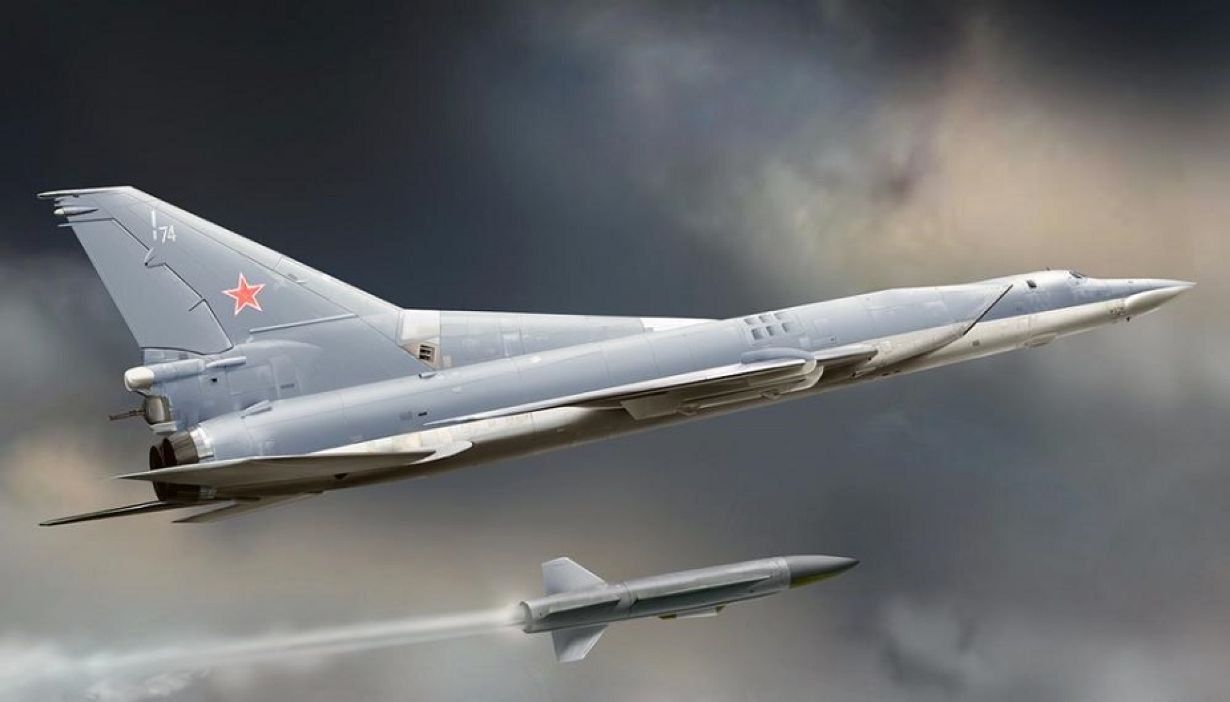Designed To Sink US Aircraft Carriers, Russia’s ‘Deadlier Than Hypersonic’ Kh-22 Missile Finally Bites The Dust

Grappling with deadly aerial strikes for several days, Ukrainian air defenders registered a major win on April 19 when they claimed to intercept the ‘invincible’ Kh-22 missile in a recent Russian missile strike.
The commander of the Ukrainian Air Force, Mykola Oleshchuk, announced on social media the first-ever successful intercept of a Russian Kh-22 missile.
The Russian forces launched a coordinated missile strike on April 19, 2024, during the night, firing six Kh-22 cruise missiles from Tu-22M3 long-range strategic bombers.
Two of the six Kh-22 missiles that were launched at Ukraine were reportedly intercepted by the Ukrainian air defense forces, demonstrating a massive upgrade in the air defense capabilities of the embattled country.
Additionally, the Tu-22M3 bomber used for launching long-range strikes was also shot down in flight for the first time since the beginning of the conflict. Russia, however, called it an accident.
“During today’s attack, two such missiles were destroyed for the first time. Ukraine needs more resources, more missiles, to better defend the front-line territories from Russian terrorism.” read the message on Telegram. Photos of the missile wreckage shortly appeared on social media.
The day marked two significant firsts for the Ukrainian forces, which have been reeling under pressure due to an uptick in Russian air strikes and the shortage of air defense missiles needed to combat the threat. It has not been ascertained which air defense system Ukraine used to intercept the Kh-22 missile and shoot down the Russian bomber.
However, social media was abuzz with speculation that the two Kh-22s, which had eluded detection up until now, were intercepted by the Ukrainians using a Patriot missile defense system. These claims could not be officially verified.
The Ukrainian military will find the news of the groundbreaking midair interceptions encouraging as they have struggled to keep up with Russia’s growing use of drone and combined missile attacks in recent weeks. The Dnipropetrovsk region has emerged as the latest example of Russia’s brazen assaults, where authorities claimed that the most recent Russian salvo had killed seven people, including two children.
The interception of the Kh-22 is significant for several reasons. The most noteworthy is Ukraine’s admission in January 2023 that the country did not have a defense against the Kh-22 missiles capable of reducing buildings to debris.
Ukraine’s air force command claimed on Facebook on January 15 last year that the Kh-22 missiles Russia used in Dnipro could not be shot down by the nation’s air defense. Until then, Ukrainian radars were generally able to detect the missile’s approximate launch position, height, and speed, but they could not shoot it down.
The Kh-22 has a maximum range of up to 600 kilometers. However, it can deviate hundreds of meters from its intended target. While the Ukrainian officials believed they could intercept the Kh-22 once they got their hands on Patriot missile defense systems, no victory was achieved until the recent strike despite the deployment of the Patriots since last summer.
This is in stark contrast to the fact that Ukraine has been able to intercept and shoot down Russian hypersonic missiles, including Kinzhal and Zircon, on multiple occasions, exposing the claims about their invincibility made by Russian President Vladimir Putin. While Russia has continued to refute these claims, Kyiv’s forces have remained resolute.
Kh-22’s Invincibility Comes To An End
The Kh-22 Burya (Storm) is a Soviet anti-ship missile capable of launching a nuclear warhead and was regarded as a long-range weapon when it was first unveiled. The main goal of the Kh-22 is to destroy US aircraft carriers and carrier battle groups with its payload.
Several Kh-22 variants were created shortly after its debut, with at least a few of the variations designed for surface targets. The missile is capable of striking strategic targets like bridges and dams. In 2022, the Kh-22 air-launched missiles with conventional warheads were regularly used against Ukrainian targets during the Russian invasion of Ukraine.
The liquid-fueled rocket that powers the delta-wing missile is typically fired from a Tu-22M3 flying at a speed of Mach 1.5. After that, the missile accelerates to Mach 3 before descending toward its target. The missile drops sharply and reaches a top speed of almost Mach 4 during its terminal phase.
By late December last year, the spokesperson of the Ukrainian Air Force, Yuriy Inhat, said Russia had launched 300 of these missiles since the start of the invasion.

Kh-22 missile.
“The Kh-22 missile flies at a speed of four thousand kilometers per hour, it enters its target mostly along a ballistic trajectory, so special means are needed to intercept it. We need air defense systems like the Patriot, so it’s not so easy with these missiles. The enemy has used more than 300 of these missiles since the full-scale invasion. In addition to the Kh-22, they also have a modernized version of this missile – the Kh-32. Probably, these missiles were also used today,” he said.
More recently, in February this year, Ukrainian forces were left flummoxed as only two-thirds of Russia’s volley of missiles and drones could be intercepted. Two Russian missile types, in particular, demonstrated why Kyiv was urging its allies for additional assistance in defending its cities, including Iskander and the Kh-22.
As previously explained in analysis, the Kh-22 and its upgraded variant, the Kh-32, are claimed to be completely invulnerable to enemy interceptors and air defense systems because they can withstand hits from 20 mm rotary cannons or air-to-air missiles.
Perhaps the Kh-32’s outstanding feature is its reported ability to exchange target information in flight with another Kh-32. According to Russian media, this ability was incorporated to outwit adversary air defense when attacking a carrier battle group (CBG).
When working in pairs, a single missile equipped with radar emission sensors could serve as a decoy in the Ukrainian scenario. It would present itself as a target to pinpoint the location of the air defense radar.
Once it located an air defense radar, it could send the coordinates to the other missile in the pair, which would jump from an extremely high elevation nearly vertically to destroy the air defense radar.
Military expert and avid watcher of Russian military, Squadron Leader Vijainder K. Thakur (retd) wrote: “Ukrainians likely fear the Kh-32 more than the Kinzhal because Russian forces have used many more Kh-32s as compared to Kinzhals; the Kh-22 variant, with its 900 kg warhead, is more destructive; and Kh-32s have proven more difficult to shoot down than hypersonic missiles such as Kinzhals and Iskander-M.”
The shooting down of these “previously invincible” missiles has demonstrated that the Ukrainian air defense forces have come a long way. Although unverified, the claims about the Patriot being behind this high-value interception might also strengthen Ukraine’s case for more Patriot batteries amid the worsening situation.
- Questions and Answers
- Opinion
- Motivational and Inspiring Story
- Technology
- Live and Let live
- Focus
- Geopolitics
- Military-Arms/Equipment
- Sicurezza
- Economy
- Beasts of Nations
- Machine Tools-The “Mother Industry”
- Art
- Causes
- Crafts
- Dance
- Drinks
- Film/Movie
- Fitness
- Food
- Giochi
- Gardening
- Health
- Home
- Literature
- Music
- Networking
- Altre informazioni
- Party
- Religion
- Shopping
- Sports
- Theater
- Health and Wellness
- News
- Culture

